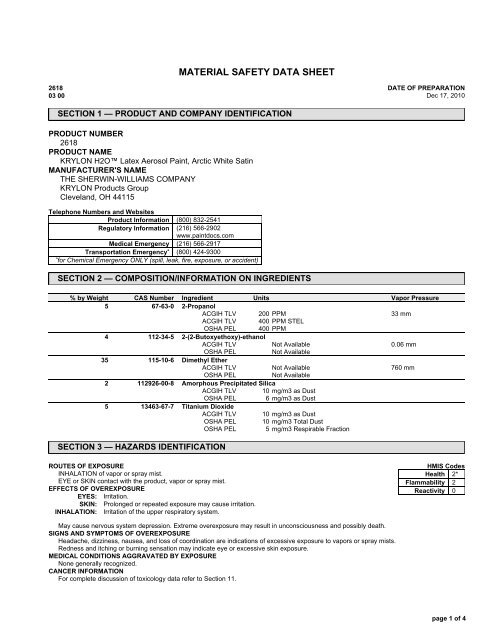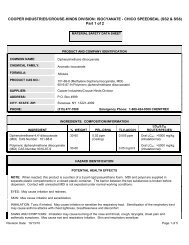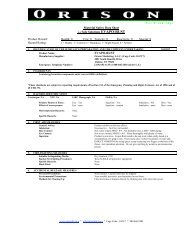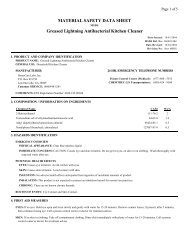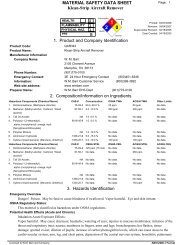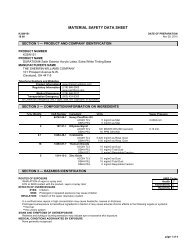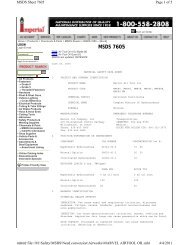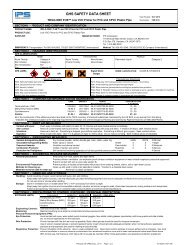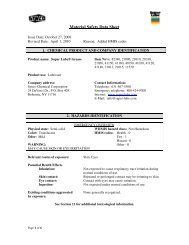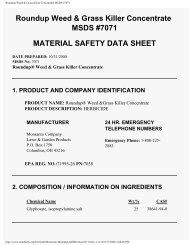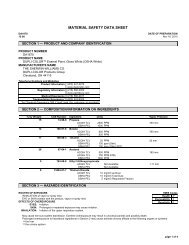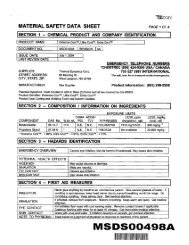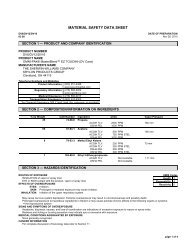sherwin williams krylon h2o latex aerosol paint arctic white satin
sherwin williams krylon h2o latex aerosol paint arctic white satin
sherwin williams krylon h2o latex aerosol paint arctic white satin
Create successful ePaper yourself
Turn your PDF publications into a flip-book with our unique Google optimized e-Paper software.
MATERIAL SAFETY DATA SHEET<br />
2618<br />
03 00<br />
DATE OF PREPARATION<br />
Dec 17, 2010<br />
SECTION 1 — PRODUCT AND COMPANY IDENTIFICATION<br />
PRODUCT NUMBER<br />
2618<br />
PRODUCT NAME<br />
KRYLON H2O Latex Aerosol Paint, Arctic White Satin<br />
MANUFACTURER'S NAME<br />
THE SHERWIN-WILLIAMS COMPANY<br />
KRYLON Products Group<br />
Cleveland, OH 44115<br />
Telephone Numbers and Websites<br />
Product Information (800) 832-2541<br />
Regulatory Information (216) 566-2902<br />
www.<strong>paint</strong>docs.com<br />
Medical Emergency (216) 566-2917<br />
Transportation Emergency* (800) 424-9300<br />
*for Chemical Emergency ONLY (spill, leak, fire, exposure, or accident)<br />
SECTION 2 — COMPOSITION/INFORMATION ON INGREDIENTS<br />
% by Weight CAS Number Ingredient Units Vapor Pressure<br />
5 67-63-0 2-Propanol<br />
ACGIH TLV 200 PPM 33 mm<br />
ACGIH TLV 400 PPM STEL<br />
OSHA PEL 400 PPM<br />
4 112-34-5 2-(2-Butoxyethoxy)-ethanol<br />
ACGIH TLV Not Available 0.06 mm<br />
OSHA PEL<br />
Not Available<br />
35 115-10-6 Dimethyl Ether<br />
ACGIH TLV Not Available 760 mm<br />
OSHA PEL<br />
Not Available<br />
2 112926-00-8 Amorphous Precipitated Silica<br />
ACGIH TLV 10 mg/m3 as Dust<br />
OSHA PEL 6 mg/m3 as Dust<br />
5 13463-67-7 Titanium Dioxide<br />
ACGIH TLV 10 mg/m3 as Dust<br />
OSHA PEL 10 mg/m3 Total Dust<br />
OSHA PEL 5 mg/m3 Respirable Fraction<br />
SECTION 3 — HAZARDS IDENTIFICATION<br />
ROUTES OF EXPOSURE<br />
INHALATION of vapor or spray mist.<br />
EYE or SKIN contact with the product, vapor or spray mist.<br />
EFFECTS OF OVEREXPOSURE<br />
EYES: Irritation.<br />
SKIN: Prolonged or repeated exposure may cause irritation.<br />
INHALATION: Irritation of the upper respiratory system.<br />
HMIS Codes<br />
Health 2*<br />
Flammability 2<br />
Reactivity 0<br />
May cause nervous system depression. Extreme overexposure may result in unconsciousness and possibly death.<br />
SIGNS AND SYMPTOMS OF OVEREXPOSURE<br />
Headache, dizziness, nausea, and loss of coordination are indications of excessive exposure to vapors or spray mists.<br />
Redness and itching or burning sensation may indicate eye or excessive skin exposure.<br />
MEDICAL CONDITIONS AGGRAVATED BY EXPOSURE<br />
None generally recognized.<br />
CANCER INFORMATION<br />
For complete discussion of toxicology data refer to Section 11.<br />
page 1 of 4
2618<br />
SECTION 4 — FIRST AID MEASURES<br />
EYES:<br />
SKIN:<br />
INHALATION:<br />
INGESTION:<br />
Flush eyes with large amounts of water for 15 minutes. Get medical attention.<br />
Wash affected area thoroughly with soap and water.<br />
Remove contaminated clothing and launder before re-use.<br />
If affected, remove from exposure. Restore breathing. Keep warm and quiet.<br />
Do not induce vomiting. Get medical attention immediately.<br />
SECTION 5 — FIRE FIGHTING MEASURES<br />
FLASH POINT<br />
LEL UEL EXTINGUISHING MEDIA<br />
Propellant < 0 °F<br />
0.9<br />
27.0 Carbon Dioxide, Dry Chemical, Alcohol Foam<br />
UNUSUAL FIRE AND EXPLOSION HAZARDS<br />
Closed containers may explode (due to the build-up of pressure) when exposed to extreme heat.<br />
Application to hot surfaces requires special precautions.<br />
During emergency conditions overexposure to decomposition products may cause a health hazard. Symptoms may not be immediately<br />
apparent. Obtain medical attention.<br />
SPECIAL FIRE FIGHTING PROCEDURES<br />
Full protective equipment including self-contained breathing apparatus should be used.<br />
Water spray may be ineffective. If water is used, fog nozzles are preferable. Water may be used to cool closed containers to prevent pressure<br />
build-up and possible autoignition or explosion when exposed to extreme heat.<br />
SECTION 6 — ACCIDENTAL RELEASE MEASURES<br />
STEPS TO BE TAKEN IN CASE MATERIAL IS RELEASED OR SPILLED<br />
Remove all sources of ignition. Ventilate the area.<br />
Remove with inert absorbent.<br />
SECTION 7 — HANDLING AND STORAGE<br />
STORAGE CATEGORY<br />
Not Available<br />
PRECAUTIONS TO BE TAKEN IN HANDLING AND STORAGE<br />
Keep away from heat, sparks, and open flame. Vapors will accumulate readily and may ignite explosively.<br />
During use and until all vapors are gone: Keep area ventilated - Do not smoke - Extinguish all flames, pilot lights, and heaters - Turn off<br />
stoves, electric tools and appliances, and any other sources of ignition.<br />
Consult NFPA Code. Use approved Bonding and Grounding procedures.<br />
Contents under pressure. Do not puncture, incinerate, or expose to temperature above 120F. Heat from sunlight, radiators, stoves, hot water,<br />
and other heat sources could cause container to burst. Do not take internally. Keep out of the reach of children.<br />
SECTION 8 — EXPOSURE CONTROLS/PERSONAL PROTECTION<br />
PRECAUTIONS TO BE TAKEN IN USE<br />
Use only with adequate ventilation.<br />
Avoid contact with skin and eyes. Avoid breathing vapor and spray mist.<br />
Wash hands after using.<br />
This coating may contain materials classified as nuisance particulates (listed "as Dust" in Section 2) which may be present at hazardous levels<br />
only during sanding or abrading of the dried film. If no specific dusts are listed in Section 2, the applicable limits for nuisance dusts are<br />
ACGIH TLV 10 mg/m3 (total dust), 3 mg/m3 (respirable fraction), OSHA PEL 15 mg/m3 (total dust), 5 mg/m3 (respirable fraction).<br />
VENTILATION<br />
Local exhaust preferable. General exhaust acceptable if the exposure to materials in Section 2 is maintained below applicable exposure limits.<br />
Refer to OSHA Standards 1910.94, 1910.107, 1910.108.<br />
RESPIRATORY PROTECTION<br />
If personal exposure cannot be controlled below applicable limits by ventilation, wear a properly fitted organic vapor/particulate respirator<br />
approved by NIOSH/MSHA for protection against materials in Section 2.<br />
When sanding or abrading the dried film, wear a dust/mist respirator approved by NIOSH/MSHA for dust which may be generated from this<br />
product, underlying <strong>paint</strong>, or the abrasive.<br />
PROTECTIVE GLOVES<br />
None required for normal application of <strong>aerosol</strong> products where minimal skin contact is expected. For long or repeated contact, wear chemical<br />
resistant gloves.<br />
EYE PROTECTION<br />
Wear safety spectacles with unperforated sideshields.<br />
OTHER PRECAUTIONS<br />
Intentional misuse by deliberately concentrating and inhaling the contents can be harmful or fatal.<br />
page 2 of 4
2618<br />
SECTION 9 — PHYSICAL AND CHEMICAL PROPERTIES<br />
PRODUCT WEIGHT 7.31 lb/gal 876 g/l<br />
SPECIFIC GRAVITY 0.88<br />
BOILING POINT
2618<br />
SECTION 14 — TRANSPORT INFORMATION<br />
US Ground (DOT)<br />
May be classed as Consumer Commodity, ORM-D<br />
UN1950, AEROSOLS, 2.1, LIMITED QUANTITY, (ERG#126)<br />
Canada (TDG)<br />
May be classed as Consumer Commodity, ORM-D<br />
UN1950, AEROSOLS, CLASS 2.1, LIMITED QUANTITY, (ERG#126)<br />
IMO<br />
May be shipped as Limited Quantity<br />
UN1950, AEROSOLS, CLASS 2.1, LIMITED QUANTITY, EmS F-D, S-U, ADR (D)<br />
SECTION 15 — REGULATORY INFORMATION<br />
SARA 313 (40 CFR 372.65C) SUPPLIER NOTIFICATION<br />
CAS No. CHEMICAL/COMPOUND % by WT % Element<br />
Glycol Ethers 4<br />
CALIFORNIA PROPOSITION 65<br />
WARNING: This product contains chemicals known to the State of California to cause cancer and birth defects or other reproductive harm.<br />
TSCA CERTIFICATION<br />
All chemicals in this product are listed, or are exempt from listing, on the TSCA Inventory.<br />
SECTION 16 — OTHER INFORMATION<br />
This product has been classified in accordance with the hazard criteria of the Canadian Controlled Products Regulations (CPR) and the<br />
MSDS contains all of the information required by the CPR.<br />
The above information pertains to this product as currently formulated, and is based on the information available at this time. Addition of reducers or other<br />
additives to this product may substantially alter the composition and hazards of the product. Since conditions of use are outside our control, we make no<br />
warranties, express or implied, and assume no liability in connection with any use of this information.<br />
page 4 of 4


